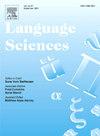附带信号和谈话质量
IF 1.1
2区 文学
Q2 EDUCATION & EDUCATIONAL RESEARCH
引用次数: 0
摘要
当我们想到谈话的质量时,会想到什么?一般来说,它是在谈话中讨论的内容,令人振奋的话题导致积极的经历,令人沮丧的话题导致消极的经历。然而,在传递会话内容的过程中也有大量的信息被交换,例如,沟通者如何将他们的话发出来,他们如何产生这些话,以及他们如何管理支持内容信息交换的对话。在本文中,我们探讨了附带信号对会话质量判断的可能影响。具体来说,我们研究并置、伴随语、插入语和修饰语如何影响会话质量。我们提供了来自各种来源的每种附带信号的示例,并讨论了每种信号可能对会话质量产生的影响。根据我们对所包括的例子的分析,我们提出附带信号可能对独立于会话内容的会话质量判断有直接影响。也就是说,对话者对对话的主观评价可能不仅仅止于说了什么,还在于怎么说。本文章由计算机程序翻译,如有差异,请以英文原文为准。
Collateral signals and conversation quality
When we think of the quality of a conversation, what comes to mind? Generally, it is the content that was discussed during the conversation, with uplifting topics leading to positive experiences, and dispiriting topics leading to negative experiences. However, there is also a great deal of information that is exchanged in the process of conveying conversational content, such as how communicators get their words out, how they produce those words, and how they manage the conversations that support the exchange of content information. In this paper, we explore the possible influence of collateral signals on judgements of conversational quality. Specifically, we examine how juxtapositions, concomitants, inserts, and modifications may influence conversational quality. We provide examples of each type of collateral signal from a variety of sources, and we discuss the possible impact each signal may have on conversational quality. Based on our analysis of the examples included, we propose that collateral signals may have a direct influence on conversational quality judgements that are independent of conversational content. That is, the subjective evaluation of conversations by interlocutors may not end simply at what is said, but how it was said.
求助全文
通过发布文献求助,成功后即可免费获取论文全文。
去求助
来源期刊

Language Sciences
Multiple-
CiteScore
2.90
自引率
0.00%
发文量
38
期刊介绍:
Language Sciences is a forum for debate, conducted so as to be of interest to the widest possible audience, on conceptual and theoretical issues in the various branches of general linguistics. The journal is also concerned with bringing to linguists attention current thinking about language within disciplines other than linguistics itself; relevant contributions from anthropologists, philosophers, psychologists and sociologists, among others, will be warmly received. In addition, the Editor is particularly keen to encourage the submission of essays on topics in the history and philosophy of language studies, and review articles discussing the import of significant recent works on language and linguistics.
 求助内容:
求助内容: 应助结果提醒方式:
应助结果提醒方式:


